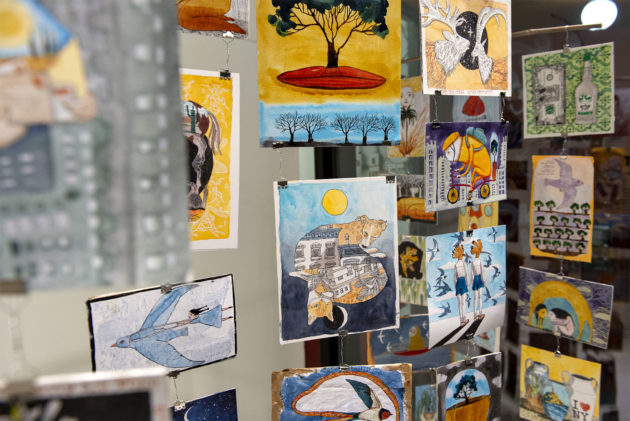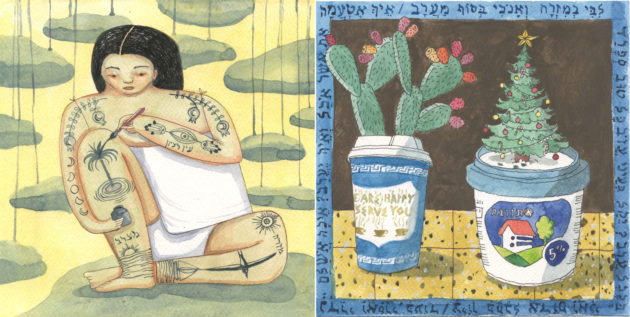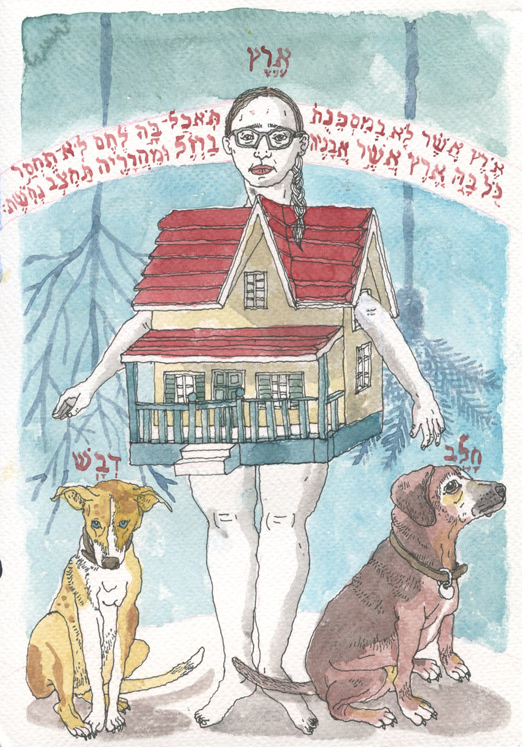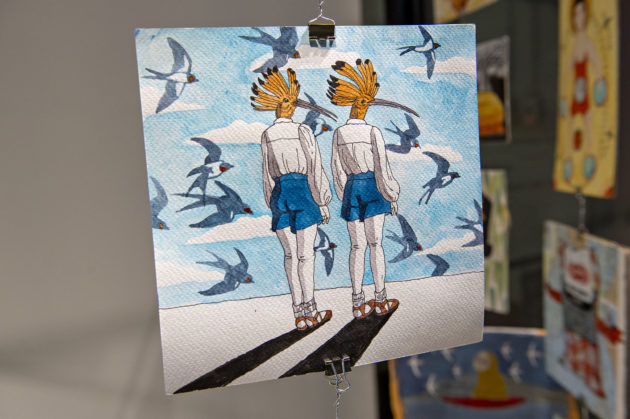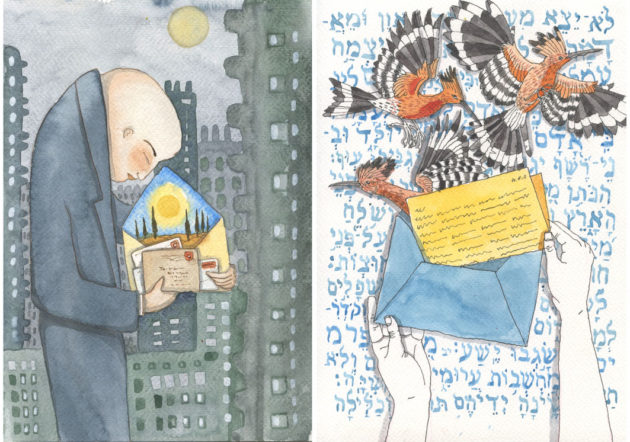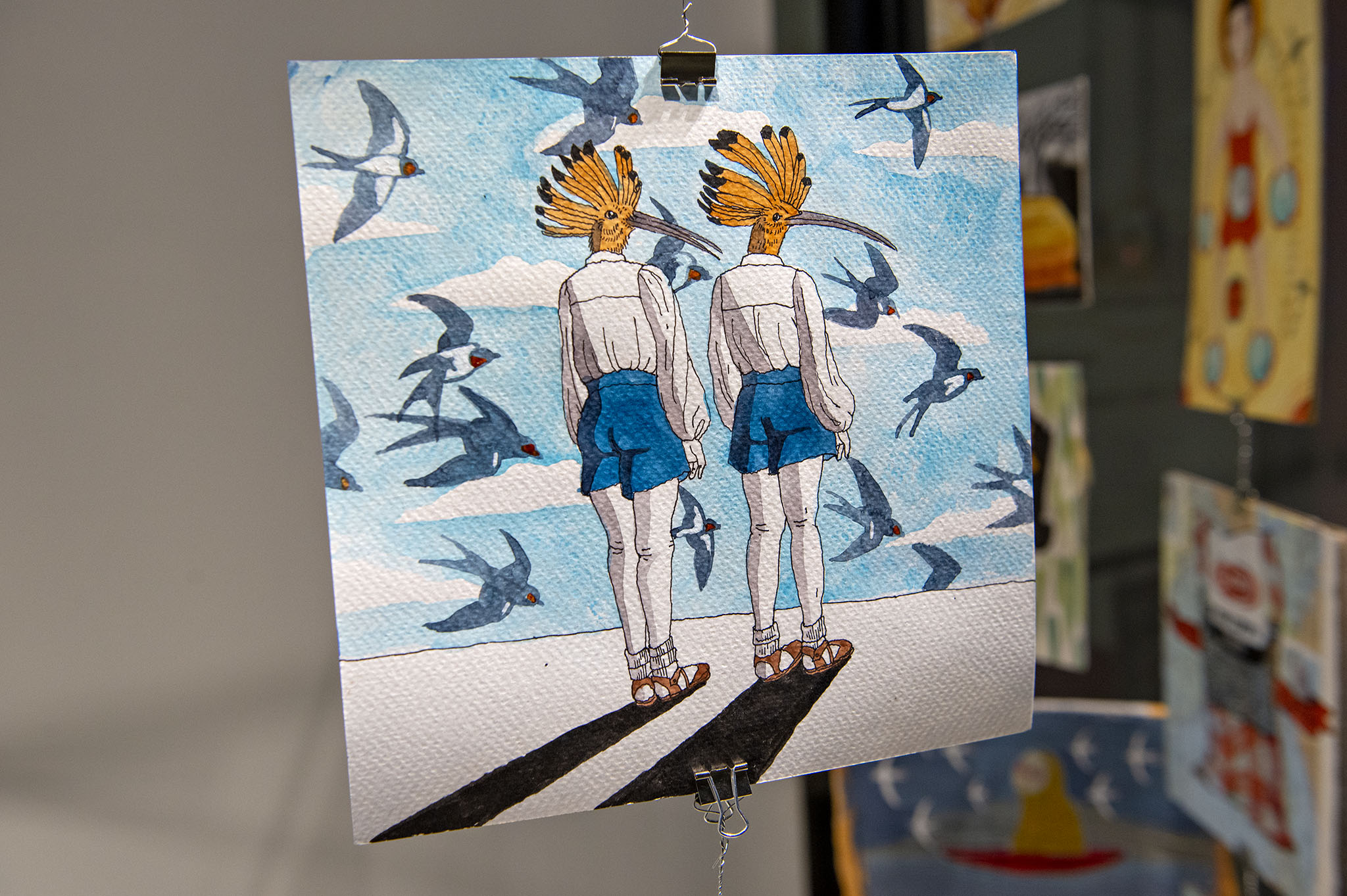
Transplant: Art By Mail
Artists Aya Rosen (Brooklyn) and Yaara Eshet (Toronto) have never met in person but they know each other very well through their artwork. These two Israeli Jewish illustrators first connected in a Facebook group for Israeli expat artists and from there, undertook a collaborative experiment. Over the last three years, they have been sending one another sketchbooks through the mail and taking turns adorning the pages with lush, vibrant illustrations.
Nearly one hundred pieces by Aya Rosen and Yaara Eshet traveled by mail across the border to create the latest exhibition in the FENTSTER window gallery in Toronto. The installation features a hanging mobile with 70 double-sided suspended pictures. To create the installation, Rosen and Eshet would each make and send a small bundle of paintings in the mail. Once delivered, each would work on the reverse side, often in response to the original image. The exhibition, TRANSPLANT, explores what it is like to be transplants to North America (where they’ve both lived for over a decade) from a place with a different culture, climate and customs.
For Lilith, Eshet and Rosen extend their correspondence—this time sending each other questions to answer instead of works of art. In this second interview, Rosen responds to Eshet’s questions.
Yaara Eshet: How does the place/country where you live affect your work?
Aya Rosen: The nature of my work has always been really personal, and I’ve always walked the line of what’s appropriate to share. I make my art because I want to be seen, but at the same time I’m afraid to be seen. New York is a city that’s incredibly easy to be invisible in. I feel more free to share myself because it’s easy to fade into the background, there’s always someone more strange than myself and people are somewhere between too polite to say anything and too preoccupied to care.
YE: How has your definition of “Israeliness” changed since you emigrated?
AR: Living in Israel, I had the great privilege of not having to think about what Israeliness is.
Everyone around me were Israelis, I was born there, and my family were born there—we were never anything else. I used to define Israeliness as a crass caricature of bluntness and rudeness, and really liked it when people told me I didn’t sound Israeli. After living in the USA for a while, I realized that the most Israeli thing is this big net of joined experiences that connect everyone. People ask “where are you going for Seder?” whether or not you’re actually celebrating Passover. Everyone goes through similar events and obligations. Living outside of Israel, the lack of that net really surprised me.
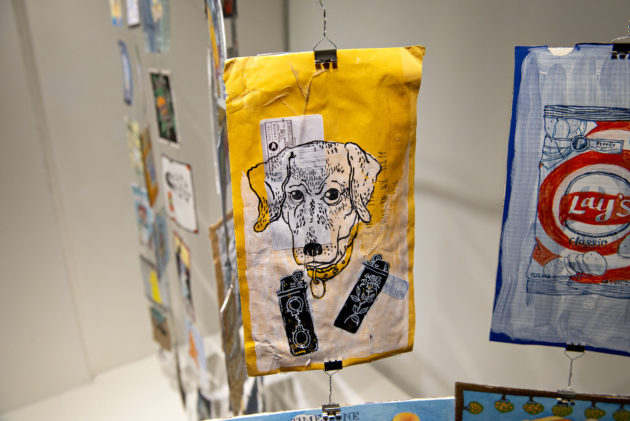
When I’m in New York, I always feel like I’m wearing the wrong things, saying the wrong thing, not knowing automatically how to behave in different types of social situations.
YE: What’s the most Israeli thing about yourself that you like?
AR: When I get excited, I talk really loud and use my hands to emphasize. I used to be embarrassed when that happened, but now I feel like being able to show my emotions in the way I talk is pretty cool.
YE: What is something that still surprises you when you go outside in Brooklyn?
AR: We go to the dog park everyday, sometimes more than once. The park is about four blocks from the East River, and at night, you can see the Empire State building. There’s something so cinematic about New York, even now whenever I see it, I feel like I’m a character in a film.
YE: Are you more comfortable reading in Hebrew or in English? Do you prefer Israeli or American literature?
AR: I read a lot faster in Hebrew, but I retain more when I read in English. In recent years I mostly listen to audiobooks with my husband, and he doesn’t speak Hebrew, so we mostly listen in English.
The Hebrew language is amazing at giving the sense of a place and reading in Hebrew feels very much like spending time in a familiar place. I love how realistic and unadorned most Hebrew literature is.
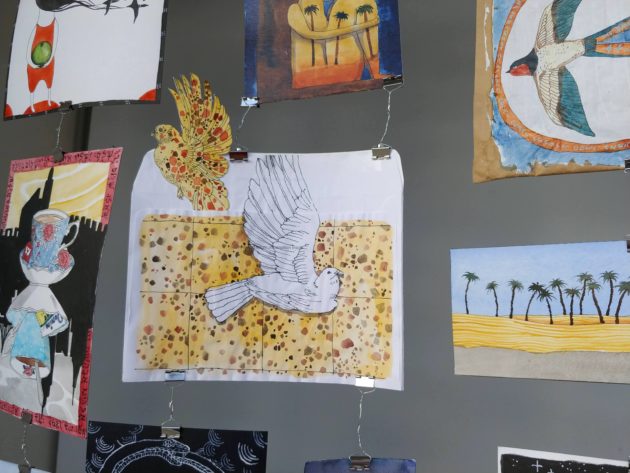
When I’m in Israel, the lack of decorum drives me nuts!
YE: What makes you feel like a stranger in Israel and in New York?
AR: Etiquette is a very American thing and not at all an Israeli thing. When I’m in New York, I always feel like I’m wearing the wrong things, saying the wrong thing, not knowing automatically how to behave in different types of social situations. When I’m in Israel, the lack of decorum drives me nuts! People blocking the way, not being considerate or even aware of other people in public spaces. In a way, I’ve always felt like a stranger, but being an immigrant made that feeling a million times stronger.
YE: If you could create a sensory capsule (one smell, one sound, one flavor, one texture, one feeling, one visual) of a place, what would you put in the Israeli one, what in the American one?
AR: Wow, that’s hard! For the Israeli one, the smell has to be eucalyptus. Those trees are all over the place—not native to Israel, but they took over. I don’t like that smell; it reminds me of being in the army. Sound: the sound of my mother walking up the stairs in their old house. Flavor: a really good tomato. Texture: for too many reasons, sand paper. Feeling: getting out of a building and being hit with an almost physical wave of heat and blinding light from the sun. Visual: a painting my father made of a woman on a roof of a small house hanging laundry on a wire.
For the USA… Smell: The smell of the gas heater of our building. I can’t smell it when I’m here, but when I go away, and come back, that smell makes me feel both like home and like a tourist. Sound: the song “Fairytale of New York” by The Pogues, it’s my favorite Christmas song. Flavor: the one, the only Dunkin Donuts coffee. Texture: fur, both for my American dogs and the faux fur on the inside of my winter hat. Feeling: the disorientation in the first 30 seconds after coming out of a subway stop. Visual: Nighthawks by Edward Hopper.
TRANSPLANT, an installation by Yaara Eshet and Aya Rosen is on view at FENTSTER @ Makom, 402 College Street, Toronto into April 3, 2022. Learn more about FENTSTER here.
Photographs of the gallery by Morris Lum.

